Vitis arizonica
| Canyon grape | |
|---|---|
 | |
| Canyon grape in Icebox Canyon, Spring Mountains, southern Nevada | |
| Scientific classification | |
| Kingdom: | Plantae |
| Clade: | Angiosperms |
| Clade: | Eudicots |
| Clade: | Rosids |
| Order: | Vitales |
| Family: | Vitaceae |
| Genus: | Vitis |
| Species: | V. arizonica |
| Binomial name | |
| Vitis arizonica | |
| Synonyms[1] | |
| |
Vitis arizonica is a North American species of wild grape. It is a deciduous vine.
Common names for the grape are Arizona grape, canyon grape, and uva del monte.[2]
Etymology
Vitis is Latin for vine, while arizonica' means of or from Arizona.
Distribution
It is found in California (Inyo County), Arizona, Nevada, New Mexico, western Texas, southern Utah, Sonora, Chihuahua, Coahuila, Durango, and Tamaulipas.[1] Within Arizona, Vitis arizonica is found in all counties, except La Paz.[3][4][5]
Morphology
Form: Vine General: Woody vine, sprawling or weakly climbing; stems generally 2–6 m long; the young twigs densely woolly, but losing this over time and the bark becoming shreddy. Leaves: Winter deciduous; broadly cordate, 3–10 cm long and about as wide, irregularly toothed and sometimes shallowly 3-lobed, more-or-less cottony hairy; petiole 1–3 cm long; tendrils opposite the leaves, bifurcate, lacking adhesive discs, withering quickly if not attached to something. Flowers: Inflorescence a loose, open, strongly branched panicle, 2–10 cm long, emerging opposite the leaves; flowers tiny with five, white petals. Fruits: Edible (but sometimes bitter) grapes, 8–10 mm thick, black.[2]
The canyon grape is a vigorously branching vine. Stems are slender, with significant tapering from base to apex. Fully developed leaves resemble a three-lobed heart shape and generally grow to an average of 4 inches long/wide. Leaves exhibit irregular toothed edge. Green flower buds develop in clusters, and small flowers bloom in a whitish green hue. Globe or ovate shaped fruit are typically 1/3-3/8 in diameter; immature fruit is green in color, developing into a deep purple or black. Fruit are clustered on red pedicels.[6]
Gallery
- Vitis arizonica
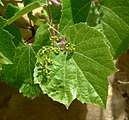
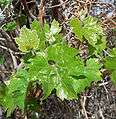
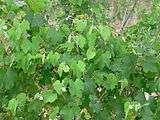
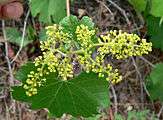
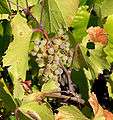
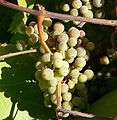
.jpg)
References
- 1 2 3 Species was first published in Amer. Naturalist 2:321. 1868 "Vitis arizonica". Germplasm Resources Information Network (GRIN). Agricultural Research Service (ARS), United States Department of Agriculture (USDA). Retrieved May 12, 2010.
- 1 2 3 "SEINet - Arizona Chapter - Vitis arizonica". swbiodiversity.org. Retrieved May 4, 2017.
- ↑ United States Department of Agriculture plants profile
- ↑ Biota of North America Program 2014 county distribution map
- ↑ Tropicos, specimen reports for Vitis arizonica Engelm.
- ↑ Littlefield, Larry J.; Burns, Pearl M. (2015). Wildflowers of the Northern and Central Mountains of New Mexico: Sangre de Cristo, Jemez, Sandia, and Manzano. Albuquerque: University of New Mexico Press. p. 360. ISBN 9780826355478.
External links
| Wikimedia Commons has media related to Vitis arizonica. |